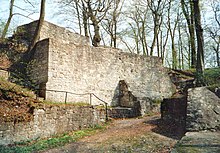Asseburg (noble family)
Von der Asseburg is the name of an old noble family from Lower Saxony that has its ancestral seat on the Asseburg of the same name , which today is only preserved as a ruin on the Asse near Wolfenbüttel . It acquired property in East Westphalia and Thuringia and divided several times. The gender has died out in its own tribe, but there is still a branch with a name through female lines (the Counts of Bocholtz and von Rothkirch-Trach ).
history
Origins in Wolfenbüttel, Peine and Asseburg
Originally the family was called "von Wolfenbüttel". Their first name bearer was Widekind von Wolfenbüttel , also Widekindus de Wolferbutle , who appears in a document between 1089 and 1118. As ministerial of Margrave Ekbert II of Meißen and Braunschweig, he had a very influential position, so that he could vouch for his master with Emperor Heinrich IV .
His great-grandson Gunzelin von Wolfenbüttel (around 1170–1255) became a Reichstruchsess and gained great importance as a military leader and statesman under two emperors, Otto IV from Guelph and Friedrich II from Staufer . He rose from the Welf service team to the Reich Ministry . In 1202 he snatched Peine from the bishops of Hildesheim and formed a small Saxon county from it. In 1206 he took part in the unsuccessful siege against Lichtenberg Castle near Salzgitter. After the death of Emperor Otto in 1218, he submitted to his successor Friedrich II.
As a Hohenstaufen adviser, Gunzelin was no longer safe in his old Welfisch-Wolfenbüttel possessions and in 1218 the Asseburg was built southeast of Wolfenbüttel. Asseburg appears for the first time around 1219 as ancestral castle and namesake of the family, namely with Gunzelin's son Burchard, who appears in a document as Burchardus de Asseburc . When Gunzelin refused to take the oath of allegiance to Duke Albrecht I of Braunschweig in 1255 , he destroyed Wolfenbüttel Castle , as Heinrich the Lion had already done in 1191 , and took control of Wolfenbüttel by terminating the fiefdom. Burchard was then besieged by Albrecht I for three years on the Asseburg until he left it in return for safe conduct and compensation. After Gunzelin's death in 1260, his sons also lost the County of Peine to the Diocese of Hildesheim.
The descendants of Widekind von Wolfenbüttel also include the gentlemen von Bartensleben , von Berwinkel , von Apenburg and von Winterfeld . All had the same or similar coats of arms with a jumping wolf. This created a large tribal and coat of arms community, which at times allegedly included up to 20 families.
Later story
From the middle of the 13th century, two lines formed. An older, East Westphalian - Thuringian line was initially located at Moringen Castle near Northeim , from 1381 to Ampfurth Castle (sold in 1712), from 1414 to Wallhausen with Wallhausen Castle (as a Mansfeld , later Electoral Saxon fiefdom), from 1493 to Gunsleben Castle and Castle Neindorf near Oschersleben , Hornhausen , Schermcke , Neubrandsleben and Peseckendorf .
In 1437 the reign of Falkenstein and Meisdorf in the Lower Harz came to the family as a fief of the bishops of Halberstadt . In the 18th century, the newly built Meisdorf Castle replaced the nearby Falkenstein Castle as a residence, which was only used as a hunting seat.
The Protestant, East Westphalian-Thuringian branch Ampfurth-Falkenstein received the title of count in the Primogenitur in 1840 under the name of Count von der Asseburg-Falkenstein ("according to the law of the firstborn from ever noble marriage"). The last count, Friedrich von der Asseburg (1861–1940) left four daughters, of which the eldest, Oda (1888–1928) married Count Leonhard von Rothkirch-Trach . Her son Lothar (1914–1984) took the name Graf von der Asseburg-Falkenstein-Rothkirch . The family's property on the territory of the Soviet occupation zone (including Falkenstein Castle and Meisdorf Castle) was expropriated without compensation in 1945 as a result of the land reform , as was Wallhausen , which belonged to the Westphalian line, and Fideikommiss Neindorf, which had fallen to a legitimate younger line, which ended in 1862 Prussian nobility as v. Asseburg-Neindorf had received.
The Westphalian line had been sitting on the Hinnenburg near Brakel since the end of the 13th century , which they had married from the noble lords of Brakel , along with other goods . It went out in the 16th century and was inherited by the older East Westphalian-Thuringian line. A new Westphalian Catholic branch emerged from this in the 17th century, from which Wilhelm Anton von der Asseburg (1707–1782) was elected Prince-Bishop of Paderborn (term of office from 1763 to 1782). This branch bore the title of baron under customary law , other branches by diploma from 1747. Shortly afterwards, this younger Westphalian branch with the electoral Cologne Prime Minister Hermann Werner von der Asseburg (1702–1779) in the male line also went out . One of his daughters married Theodor Werner von Bocholtz in 1793 . Their second son Hermann Werner inherited the Hinnenburg and Wallhausen and was raised to Count Bocholtz-Asseburg in 1803 . The last of this line, Count Busso (1909–1985), adopted Count Friedrich von der Asseburg-Falkenstein-Rothkirch (1952–2013), son of Count Lothar, who converted to the Catholic denomination, and bequeathed the former family fideikommiss Hinnenburg to him; he was followed by his son Louis.
coat of arms
The family coat of arms shows a black wolf ready to jump in gold . On the crowned helmet stands a red column covered with a gold-framed mirror, which is decorated with nine natural peacock feathers on top. The helmet covers are black and gold.
Coat of arms from Siebmacher's coat of arms book from 1605
Coat of arms graphic by Otto Hupp in the Munich calendar of 1923
Well-known namesake
- Widekind von Wolfenbüttel (also Widukind, Widukindus; * after 1089, † around 1118), builder of the moated castle Wolfenbüttel and founder of the line of those von Wolfenbüttel-Asseburg
- Gunzelin von Wolfenbüttel (also Gunzelin von der Asseburg; * around 1170; † February 2, 1255), ministerial from the line of those von Wolfenbüttel-Asseburg
- Bernd von der Asseburg (1451–1518), builder and part of several Harz legends
- Johann von der Asseburg († 1567), imperial field bishop
- Rosamunde Juliane von der Asseburg (1672–1712), religious visionary of early Pietism
- Moritz Wilhelm von der Asseburg (1698–1780), Prussian major general
- Hermann Werner Freiherr von der Asseburg zu Hinnenburg (1702–1779), leading minister of the Electorate of Cologne
- Friedrich von der Asseburg auf Hindenburg († 1704), Knight of the Teutonic Order
- Wilhelm Anton von der Asseburg (1707–1782), Prince-Bishop of Paderborn
- Achatz Ferdinand von der Asseburg (1721–1797), diplomat
- Ludwig Graf von der Asseburg (1796–1869), Lord of the Minorgrave Falkenstein, Prussian court hunter and member of the Prussian manor house
- Anna Countess von der Asseburg , b. Freiin von Kleist (1830–1905), owner of the Neudek estate
- Egbert Hoyer von der Asseburg (1847–1909), Prussian lieutenant general and sports functionary
- Friedrich von der Asseburg (1861–1940), Prussian officer and chamberlain
- Maximilian von der Asseburg-Neindorf (1874–1945), manor owner, administrative officer and member of parliament
See also
- List of German noble families
- List of the Paderborn noble families
- List of Westphalian noble families
literature
- Johann Bernhard Graf von Bocholtz-Asseburg: Asseburg document book. 3 volumes, Hanover 1876, 1887 and 1905. (Reprint: Wenner, Osnabrück 1975, ISBN 3-87898-164-3 )
- Genealogical manual of the nobility , Adelslexikon Volume I, Volume 53 of the complete series, CA Starke Verlag, Limburg (Lahn) 1972, ISSN 0435-2408
- Ernst Heinrich Kneschke : New general German nobility lexicon . Volume 1, Friedrich Voigt's Buchhandlung, Leipzig 1859, p. 127. (digitized version)
- Leopold von Zedlitz-Neukirch : New Prussian Adelslexicon . Volume 1, Gebrüder Reichenbach, Leipzig 1836, p. 147. (digitized version)
- Leopold von Zedlitz-Neukirch : New Prussian Adelslexicon . Supplement - Volume 2, Gebrüder Reichenbach, Leipzig 1843, p. 5. (digitized version)
Individual evidence
- ↑ Ludwig Gustav von Winterfeld -Damerow: History of the family of Winterfeld, self-published 1858, Volume 1, pp. 72–73 u. a.
- ↑ With the approval of the Prussian Ministry of the Interior of January 17, 1937, GHdA Gräfliche Häuser Vol. XIII 1991, p. 283
- ↑ GHdA, Noble Houses B XIII 1980, p. 11
- ^ Marcelli Janecki (arrangement): Handbuch des Prussischen Adels , Volume 2, ES Mittler & Sohn , Berlin 1893, pp. 31–32












